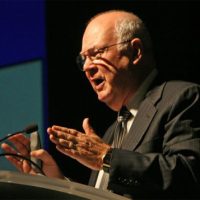
By Heidi Simmons
With 770 people in attendance, the Coachella Valley Annual Economic Summit was held October 30 at the JW Marriot Desert Springs & Spa in Palm Desert. For a decade, Coachella Valley Economic Partnership (CVEP) has hosted the event that gives a detailed account of the valley’s economic strengths, weaknesses and challenges.
Established in 1994, CVEP is a non-profit organization that is focused on the valley’s economy. Its mission is attracting, maintaining and expanding business and developing a high-skilled workforce to enhance the economy and the vitality of life in the region.
Emphasizing education, CVEP recognizes that to attract 21st Century companies and jobs to the valley, it must collaborate with educators. CVEP puts together businesses and schools to create career-specific programs by providing work-based learning. Internships, job shadowing and scholarships are some of the ways CVEP seeks to build and improve the workforce, grow businesses and encourage entrepreneurs.
This year’s keynote speakers included economist John Husing, Ph. D. and author Dan Schawbel. Both are experts in their fields and delivered informative presentations.
Husing’s specialty is the Inland Empire economy. The Los Angeles Times listed Husing as one of the “100 people wielding the most influence over Southern California.”
For the CVEP Economic Summit, Husing analyzed the current condition of agriculture, health care, retirees, tourism, hotels and conventions, tourist shopping, creative arts, poverty, clean technology, Coachella Valley competitiveness, distribution, construction, manufacturing and California competitiveness. He gave each a grade letter grade from A to F.
Husing began by asking the crowd if they thought the economy had not changed over the last year. A few hands went up. But the majority of attendees believed it had improved.
Unemployment
And indeed, Husing says, it is improving. Since 2007 and through the recession, the Coachella Valley lost 19,232 jobs. By the end of the year, he estimates that the valley will gain 14,644 jobs and the deficit of 4,500 will be restored in the next year. The CV unemployment rate is 8.5 percent, lower than the county’s 9.2 percent.
According to Husing, the value of the dollar has become much stronger. “It means that buying goods from the rest of the world is less expensive for us,” said Husing. “Selling to the rest of the world, our products have become more expensive. So it’s bad for those companies trying to export to other parts of the world.” He said that the nation’s inflation is running under two percent. And with oil prices down, he said people have discretionary funds to spend on other things, which is good for the economy.
“When we look at the national economy, the set of forces that the valley swims in is very strong,” Husing said. He thought that the numbers from the Southern California Development Department underestimate how well So Cal is actually doing. He believes when the report is revised in March, it will show significant improvement.
Energy
Regarding industrial energy costs, Husing said that California’s energy policy has resulted in 43.4 percent more expensive rates than the second highest of the western states. Referring to a graph with California at the top, he said, “If you want an economy that is competitive, you do not, on purpose, create that chart.” The crowd clapped when he said the California State Legislator was moving in the wrong direction.
There was a murmur of concern when he suggested that going all-solar was crazy. “If we are going to do anything, we should be relying heavily on natural gas as we go forward. The issue of the South Coast Air Quality Management District (SCAQMD) is increasingly saying we must electrify the entire area and not rely even on natural gas. I would suggest to you that is a policy consideration that is crazy.”
Husing said the air quality of the CV is far better than other urban areas of our competitors. The main air quality issue for the CV is Salton Sea. Rules and regulations that come from that SCAQMD impact the valley’s competitiveness and poverty. He said the question must be asked: “As a desert area, does this make sense to belong to that organization? For me as an analyst, it makes no sense.” Husing sees the SCAQMD as a real problem for CV manufacturing.
Education
Regarding the quality of the labor force, Husing said, “These probably are our scariest numbers.” Those with a Bachelor’s degree and above are 24 percent of the CV population versus 20.1 percent in the Inland Empire. Husing said, “We have a real challenge of getting kids into college, keeping them there and then holding them when they come out. That is our most serious difficulty.”
The regional population that stopped at high school or less is 45.4 percent. Husing said it would be worse if he took out the retirees who are very well educated. At 46.3 percent, the Inland Empire is closest to the level of education in Albuquerque and Los Angeles.
“In a modern economy, a high school diploma qualifies you for very low income work. You’ve got to get beyond that either in technical training or above whether at community college, CSU, UC or private school systems.” Husing believes there needs to be a continued focus on education. Students do better if they can see a relationship with what they are studying and what they can do. Education needs to be related to real world occupations.
Home Prices
The median home price in the CV was $371,700, which is cheaper than other California cities. Indio has the biggest home sales up to 70.5 percent from 22 percent. Fifteen percent of valley homes are still under water. In Riverside county, 41 percent can afford 50 percent of the homes.
Industrial space in less expensive in the CV and offers a very competitive advantage.
Poverty
As for poverty, Husing said one in five people live in poverty. In our three school districts, students in poverty under the age of 18 are 50 percent in Coachella’s district, 40 percent in Palm Springs’ district, and 20 percent in Desert Sands’ district. “Stop and think of the barrier you are placing in face of those people who have to get educated to be our future labor force, and those numbers become frightening,” said Husing. “We have real battles to fight there.”
The problems of poverty include: Socio economic causes — 40 percent, health behaviors — 30 percent, access to medical care — 20 percent and environment — 10 percent. Husing said, “I would suggest to you that part of the problem we have in California is we have spent an enormous amount on the 10 percent and we have tended to let the 90 percent fend for itself. We really do need to change those priorities.”
Solution for Poverty
Husing emphasized the need to build a middle class with an annual income of $40,000. To attack the issues of poverty, Husing offered four solutions: One — short course adult training in specific skills to get people in the middle class. Two – simplify getting started in sectors with fewer educational barriers. Three – create medium incomes that approach middle class earnings. Four — skill ladders up, where people can move into medium incomes.
According to Husing, jobs that pay over $40,000 are logistics, manufacturing, mining, oil and gas and construction. Also generating a middle class salary are health care, finance and real estate, but they have higher requirements to get into those professions.
CVEP’s Challenge
Husing said that he brags about CVEP. “What is extraordinary about CVEP is the work being done in order to create a pipeline into health care, advanced tech, art, media and entertainment fields,” he said. “With all of those various techniques being used like job shadowing, faculty externships, industry mentors, creative critiques of student work, academic instructional programs and scholarships, this is unprecedented. It is extraordinary for someone like me to see.”
One of the most important things Husing wants to see happen is for people to get out of the recession mindset of being afraid. He said it is probably the hardest barrier to overcome. Another issue the valley faces, is the need for infrastructure in the East Coachella Valley to accommodate the population growth.
Husing said the CV has a “big shot at logistics” with the railway running through the valley. He suggested there needs to be fulfillment centers –– companies who store, receive orders, package and ship mostly online purchased items to consumers.
Husing’s Economic High Lites
Taxable retail sales are headed to a record high. Agriculture is up 13.2 percent with the valley’s high value crops.
Hotel occupancy levels have almost completely recovered. The Palm Springs Airport had a record 9.7 percent increase.
BMW is building a training and performance center in Thermal.
The CV Link — a valley thoroughfare for walking, jogging, biking and driving of electric vehicles, Husing said would be a major tourist draw and that the funds were almost in place.
One third of the valley is 55 years old or older. They are about to retire or are retired. Accommodating their active life styles will continue to improve the economy.
The CV population growth is expected to go up and the Affordable Care Act saw a 422,000 sign up — one of the most successful sing-ups in the country.
iHub
Most impressive is the high tech programs with iHub – the innovation center in Palm Springs for early stage companies and entrepreneurs in the fields of energy, health and medical, and arts, media and entertainment. IHub is getting Federal and private grants that are on the level of Boston’s MIT. Husing wants to see more employment generated by those iHub entrepreneurs.
Film Industry
Over twelve months, the film industry had a $7.7 million economic impact in the CV. Husing said he’d like the California film credit program expanded.
Finally Husing said he most wants the construction industry to get back to where it was before the recession. Construction is an important component in a growing economy.
Before Husing thanked the crowd he said he was optimistic. “I think in 2015, the numbers are going to look normal.”
Millennials
When author Schawbel took the podium, his message to businesses about Millennials — the generation born between 1982 and 1993 — was simple: Be flexible, be honest, have integrity and a social conscience.
Currently Millennials make up 36 percent of the American work force. By 2025 they will be 75 percent. The next group is Generation Z. And according to Schawbel they see the world even more differently than Gen Y.
Peggy Sue Lane, Vice President of Business Development at American Title was a charming emcee. At one point when it seemed Husing might never get to the CV’s final grade, Lane calmly walked toward the podium. When he saw her heading his way, he quipped he wasn’t leaving until he was done. Without saying a word, Lane graciously made a U-turn and exited. Husing soon concluded.
Our Desert. Our Economy. Engage.
The CVEP Summit was a year in the planning. Six months ago they had the location and in June they had the speakers. “We really wanted someone dynamic and with a professional approach,” said Lane. “We recognized that in five to seven years the Millennials will dominate the workforce.”
Rick Axelrod of LifeStream (a blood collection service) and Chairman of CVEP, gave the opening remarks and commented that with a growing dynamic community, it would attract new families and more blood donors and help LifeStream sustain lives. He was passionate about CVEP’s mission to create a well-trained and educated workforce.
Performance
Beside all the fascinating economic details, one performance really stood out. Tim Kepler, an ex con and ex drug addict with a real-life Dickensian story, performed the National Anthem. Robust and vibrant, Kepler held long notes and confidently reached the highs and lows, stunning the crowd his voice and charisma.
“I’ve always been a singer,” said Kepler. “Some people write, some work on computers, I love to sing and share my gift.” Kepler has been sober for 22 years and is married with two boys. One son just finished college and the other is just starting. “If I can bring someone joy by singing, then I’ve done my job.”
CVEP’s Director of Administration and Facilities, Lesa Bodnar heard Kepler sing at an Air Quality Management District award event in Los Angeles. “It was the best rendition of the National Anthem I ever heard. I thought he’d be great for our event,” said Bodnar. “I asked him if he was available and he check his calendar. I was thrilled when he said he could perform.”
Kepler greeted the event guests with a joy-filled and heart-felt “Happy” by Pharrell Williams. Many guests didn’t realize he was singing live on stage because it was so good. Kepler lives in Anaheim and has sung for the Angels and the Lakers and tours the country.
Presenting sponsors were Desert Regional Medical Center and JFK Memorial Hospital. The Gold Sponsor was Wells Fargo and there were more than a dozen Silver and Bronze sponsors. All nine cities of the CV were sponsors as well.
CVEP has a staff of 25 and nearly 100 Investors and Scholarship Matching Partners. Investing partners with CVEP gain valuable business leads, marketing data and networking opportunities with the area’s top businesses and civic leaders.
Husing’s final grade for the CV was a “B minus.” Last year’s grade was “C plus.” It looks like the economic picture of the Coachella Valley is improving. Kind of.
Report Card
Agriculture A+
Health Care A
Retirees A
Tourism A-
Hotels and Conventions B+
Tourist Shoppers B+
Creative Arts B-
Attacking Poverty C+
Clean Tech C+
CV Competitiveness C
Distribution C
CA Competitiveness D-
Manufacturing D-
Overall Grade B-












































